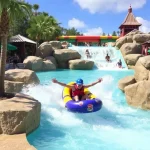
I really like fishing Gulf oil rigs. I personally don’t like fishing Gulf oil rigs.
What makes up about this love/hate relationship? Around the one hands, since these offshore structures are the place to find barrier-reef environments that attract many large predators, it’s unlikely you’ll cash trouble linking whenever you drop a jig or bait.
However, as you have to fish so near to the structure, don’t search for real high likelihood of landing whatever snatches your offering, unless of course you’re extremely fast and/or lucky, and taking advantage of tackle much heavier than you’d otherwise have to don’t get “rigged.”
But there’s an alternate — one which many (literally) overlook.
From Sight = From Mind
“It’s amazing how most anglers here have tunnel vision,” Capt. Rimmer Covington states, once we go out one of the numerous passes south of Venice, Louisiana, by which Mississippi River water churns. “We’re so spoiled, because of so many rigs to fish we run right over rigs, reefs, pipelines, wrecks along with other relief that people can’t see, never stopping to decrease a line.”
In a single day’s shedding jigs over various relief while fishing aboard Covington’s 39-feet SeaVee, I had been one of many anglers to trap grouper — yellowedge, scamp, Warsaw, snowies, gags, reds — plus red and grey snapper, almaco jack, amberjack, bull redfish, true Atlantic bonito, kingfish and much more.
Obviously, it may also help to possess a Gps navigation filled with figures marking such open-water structure (OWS). Covington and the partners within the Mexico Gulf Fishing Company, located in Venice, owe their livelihood to knowing such spots. But along with some effort, weekend anglers could possibly get in the loop, too.
For instance, individuals that do some homework could possibly get their rods bent regularly by shedding to rigs which were toppled included in Louisiana’s rigs-to-reefs program.
(That condition program, incidentally, while of worth, is restricted in scope and may do little in order to save the 650 approximately oil platforms now scheduled for destruction and removal over the following 5 years through the Department from the Interior, as described in SF’s April editorial.)
“There are nearly 30 toppled or cutoff rigs within achieve on an excursion from Venice,” Covington highlights. “Numbers of these are for sale to the general public through Mississippi and Louisiana marine-resource agencies.”
Anglers will find many submerged rigs off Louisiana at wlf.louisiana.gov search “artificial reef program.” For Mississippi waters, visit dmr.ms.gov search “marine fisheries” and “artificial reef.”
Generally, Covington states submerged structure/relief within the northern Gulf will get much less fishing pressure than rigs, both because they’re eminently visible as well as present an easy spot for tying up.
The Fundamental Sounder
The very best OWS or relief of any sort will probably be that you are, and pretty much as good are figures you receive from the friend. Chances are these may be recognized to relatively couple of anglers.
Covington highlights he attempts to monitor his sounder while going around, marking anything he passes over that appears interesting so he is able to return and take a look sooner or later. His Gps navigation is filled with figures, marking not just rigs or bits of them, but large rocks, interesting hard-bottom patches, wellheads, pipeline junctions and wrecked vessels.
“I’ve found many these spots,” the skipper states, “mostly accidentally — by having to pay focus on the sounder. That’s the most crucial device on my small boat. Despite a restricted budget, you need to allocate around you are able to towards the greatest-quality sounder you’ll find.Inches
For Covington, that’s a Simrad NSO15 with CHIRP technology, along with an Airmar 3-kilowatt transducer with frequencies varying from 33 to 210 kHz. An especially welcome feature on his sounder, Covington states, may be the BackTrack that “allows us to scroll to structure which has already scrolled from the screen, and mark its location without getting to show the boat around and discover it again.”
Covington advises anglers acquainted with rig fishing to scale lower their tackle, an additional advantage.
“When fishing rigs, you frequently need a lot continue such heavy tackle and line that anglers need to fight the fish using the fishing rod within the holder,” he states. With lighter gear, they are able to fight the fish by themselves. Additionally you will dsicover you’ll need less terminal gear, since structure you’re fishing over isn’t as grabby much like submerged legs and cables of rigs.
Among spots with structure or relief at the base, its smart and to keep close track of what is visible at first glance, since habitat of the different sort might attract what you’re after. “Surface structure” usually takes the type of a spead boat at anchor or perhaps a weed line, like the one we discovered while running to some place.
Covington slowed so we started casting into it with lead‑heads and crankbaits, searching for tripletail, jacks and perhaps cobia. We found a pod from the latter — or possibly it had been they who found us — and rapidly connected a few within the 20- to 30-pound range. Individuals smaller sized fish had beaten one significantly bigger towards the punch after i dropped a jig having a 14-inch chartreuse Hogy tail before it, the large cobe pounced. After a little exciting moments, a missed swipe having a gaff knocked them back in the boat fortunately, it was not a “release” I truly minded making.
Top-Lower Fishing Style
However for its benefits, fishing OWS has its own challenges too.
“Fishing structure or relief in open water requires some skill,” Covington states, “since you may have to carry the boat directly over spots that may be really small. Some we fish aren’t any bigger than the usual picnic table.” Covington’s favorite places are fairly deep (200 to 400 ft) in water frequently churned by hard currents and choppy seas. Therefore the helmsman has to understand his stuff to sit down tight and let anglers’ lines achieve bottom. (Drift too quickly and all sorts of could easily get hung before any could possibly get bit.)
Sometimes the tiniest section of relief holds big surprises. But Covington lists as favorite open-water structure oil platforms stop in 300 to 350 ft with a minimum of 60 % of the height from bottom to come to light still intact.
When fishing such platforms, Covington employs a top‑down approach. “First, we fish shallow — from the top cutoff structure towards the surface — for mangrove snapper, cobia and nobleman. Then we’ll work from the top structure lower to within about 30 ft of bottom with big live baits and Butterfly-type jigs for red snapper, AJ, almaco, and gag and scamp grouper,” he states. “Then, we’ll complete at the base for grouper — snowies, yellowedge and Warsaws.” He’s found OWS, including hard-bottom reefs, towards the west that hold other species, for example speckled hinds and longtail bass.
It’s important to note that in the times I fished OWS with Covington, i was hooking red snapper between close to the surface to shut to bottom. One time, we fished a toppled rig that found within 40 ft from the surface, and Covington and Capt. Scott Sullivan soon had live-chummed almost to the peak a wad of mangrove snapper that averaged 6 to 9 pounds. Shedding liveys without any weight introduced immediate hookups.
Another OWS favorite: pipeline crossings. “They normally have a maximum of 10 ft of vertical relief but appear best at attracting grouper. The biggest scamp and red grouper I’ve seen were caught on crossings,” Covington states.
Finally, he mentions pinnacles and salt domes, that offer a bigger area and, for individuals not familiar with such fishing, more drift time for you to keep baits lower.
**
Wahoo Wonderlands**
Covington follows a loose tripartite calendar for fishing open-water structure off eastern Louisiana.
The month of january – April: “I prefer to troll and chunk — especially cutoff rigs rich in relief — for wahoo, yellowfin and blackfin tuna,” Covington states. Go much deeper and hook amberjack and scamp.
May – September: Prime time on OWS for example pipeline crossings or rocks for snapper (both grey and red), grouper, AJ, cobia and periodic pelagics. “This is another good way within the summer time to create bait: We catch a larger number of bait than around oil platforms, from bonito and little blackfin for marlin towards the blue runners, goggle-eye, and sardines we use for summer time yellowfin and dolphin.”
October – December: “We possess a magnificent run of really big wahoo — fifty to one hundred pounds and much more — plus they like to congregate around open-water structure,” Covington states. As during the cold months, grouper present an option lower below, including Warsaws, snowies and yellowedge in 400 approximately ft.
In certain respects, outdoors-water-structure fishing could be too good. Specially when fishing on small spots, states Covington, “the most significant factor would be to move after taking only a couple of use anyone place. A number of these open-water spots are small and could be rapidly fished out.”
But such specific, open-water drop zones will invariably get much less pressure than rigs that rise far beyond the top. Couple by using responsible fishing, and you may rely on the myriad rigs and reefs you cannot look into remain a few of the northern Gulf’s best bets for doing things.
TRIP PLANNER
While there are several acceptable hotels near Venice, Covington and the associates can hold groups as high as 12 within their lodge.
Contact Details
Fishing:
Mexico Gulf Fishing Company four captains — Rimmer Covington, Scott Sullivan, Kevin Beach and Billy Wells — run four fast offshore motorboats visit
www.mgfishing.com or call 601-951-3981.
General information:
www.plaqueminestourism.com, 888-745-0642 or 504-394-0018
Marinas:
Venice Marina www.venicemarina.com, 504-534-9357
Cypress Cove Marina www.cypresscovevenice.com, 504-534-9289
Resourse: http://saltwatersportsman.com/gulf-coast-fishing/
Reading the Beach – Identifying Sandbars, Troughs, & Cuts
COMMENTS:
richtroxler: Well I finally broke down and ponied up the dough for a GoPro camera, so my video quality should take a quantum leap. Got the headstrap so that I can fish and shoot at the same time, so I'll be mixing in some fish catching video with the informational stuff. Fish catching video footage is fun, but most of my videos are an attempt to stuff as much information as I can fit in them. When ever I finish a video, there's 20 more things I wanted to talk about and didn't get to lol.
Jimmy Ramos: richtroxler haha if you don't what that means you might wanna get your fish at the store.
richtroxler: It means spent the money.
311POPE: Hands down this is by far the best example of how to read beaches. You did an outstanding job explaining all the different features with perfect photos. I do not know Mr. Richtroxler but know we would be fishing the exact same beach if we lived in the same area. Very nicely done!!
Troy Cox: +311POPE I agree entirely. This video is the best i've watched on the topic. I'll be watching it repeatedly throughout the week – going surf fishing for the first time next weekend.
richtroxler: Just a reminder / disclaimer. Structure does not magically produce fish. They have to be in the area to begin with. If they are, then identifying the structure they prefer to feed around will help you dial in their location. Good luck on your first trip. Surf fishing is a life long learning process that never ends. Enjoy the ride.
Mike Goforth: Great video. No meandering artsy fluff like some of these videos, just vital information clearly delivered. For a surf fishing neophyte, this is pure gold. Thanks a million, Rich!
richtroxler: +Mike Goforth You're very welcome Mike.
Michael Rk: Mr. Troxler, you leave me somewhat speechless. You are by far one of the most informative instructors on Reading the Beach. Thank you so very much for these videos. You just made me a better fisherman…
I SSMDad: Thanks for the great video. The volume was a bit low though even with it turned all the way up so I had to find a pretty quiet place to listen.
richtroxler: +Chris SSMDad You're welcome Chris. Still haven't figured out the volume thing. I record the narrative using protools and the volume seems loud enough. Then when I use MovieMaker it seems to kill the volume when I generate the video. Maybe one day I'll buy a real video editing program lol.
Emmanuel Casillas: +richtroxler thank you for this big information you just inspired me to go fishing tomorrow morning
Craig Pence: No audio problem for me. Your lessons are succinct and logical, and the videos are well produced. Thanks for taking the time to think through the topics and present them so well in this excellent series of tutorials. I'm about to leave for 3 weeks in Florida and I'll be flyfishing the beaches a lot. I'm a midwestern fresh water fisher who knew nothing about beach structure. Your videos will help me get off to a great start.
richtroxler: Thanks Craig.
richtroxler: Happy New Year and tight lines to all!
Twan Wilting: Hey, maybe an offtopic question\nBut does anyone of you know how the size of a sand-bank/sand-ridge is influenced by for example velocity, grain size/ slope of bottom/Keulegan-Carpenter number?\n\nThanks ^^\nIll subscribe if you have an answer ^^\n\nTwan
richtroxler: LOL, never thought I'd hear the term Keulegan-Carpenter number again. Although fancy sounding, your question is non-specific. therefor unanswerable.
TC Raleigh: Great information. Thanks for taking the time to produce.
TheMandalore04: Rich, this video series has been great. I really appreciate the time you've put into this.
richtroxler: I appreciate you watching them :-)




